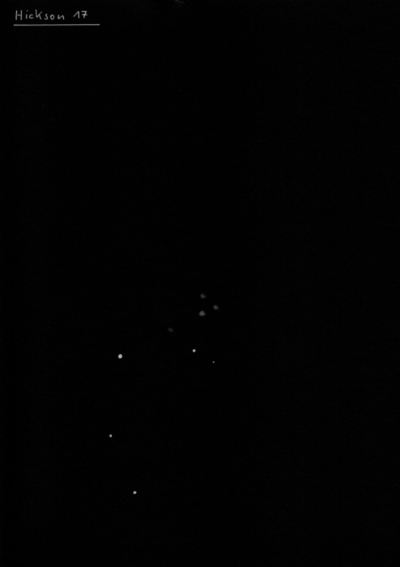Aries is officially the first constellation of the zodiac, as 2,000 years ago, it contained the vernal equinox - the intersection of the ecliptic with the celestial equator. However, due to precession, this point is now located in the neighboring Pisces constellation (although the symbol for the vernal equinox remains identical to the Aries constellation). The vernal equinox is the point where the Sun crosses the celestial equator, marking the beginning of spring. In ancient times, the ecliptic was divided into 12 equal sections of 30 degrees each, known as the zodiac signs. Today, the Sun travels through Aries each year between April 18th and May 12th. Aries is a small but distinctive constellation, and its framework is formed by the bright stars Hamal, Sheratan, and Mesarthim, located near the line of stars characterizing the Andromeda constellation. The constellation features several binary stars and faint galaxies, with NGC 772 being the most notable among them.
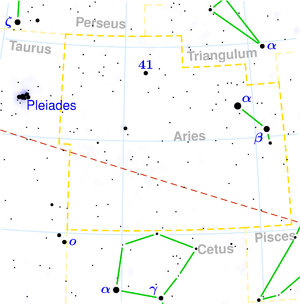
Hamal (α Aries) - The brightest star of the constellation, otherwise unremarkable. This red giant of spectral class K2 has a magnitude of 2 and shines at a distance of 66 light years. Sometimes the star is also referred to as El Nath.
ε Arietis - Binary star, white components with nearly the same brightness (5.2 mag and 5.5 mag) at a separation of 1.5". We can sufficiently separate them with a magnification of 150x using a 200 mm telescope during good seeing.
Mesarthim (γ Arietis) - A charming double star, composed of blue-white components with magnitudes 4.7 and 4.8, separated by 7.8", which can be resolved with a 5 cm telescope. Mesarthim is visible to the naked eye as a star with magnitude 3.9. Historically, it is interesting because it was one of the first double stars discovered by a telescope, observed by the English naturalist Robert Hooke in 1664 while observing a comet. It is located 204 light-years away.
λ Arietis - Double star easily distinguishable in a 10 cm telescope. The yellow-white star (4.9 mag) is located 37.4" away from the pale blue component (7.7 mag).
Musca Borealis (Severná mucha) - The now non-existent constellations, which once consisted of three stars of the constellation Aries - 35, 39, 41 Arietis, representing buzzing sea flies settling on the ram's tail.
NGC 772
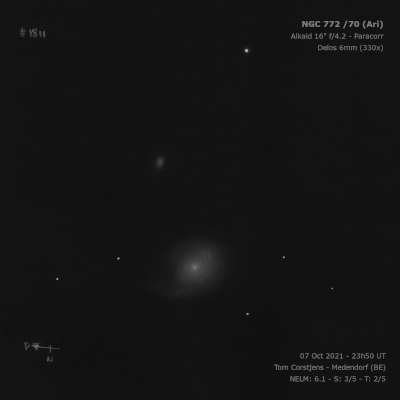
William Herschel discovered NGC 772 = H I-112 = h181 on 29 Nov 1785 (sweep 481) and logged "cB or vB, L, R, mbM, 3 or 4' dia, difficulty resolving. In the most resolvable part a faint red colour perceivable." On 3 Nov 1855, R.J. Mitchell wrote "...One branch in particular strongly suspected as at A [in diagram] curved towards the * preceding." This description refers to the northern spiral arm and star preceding (indicated on the diagram) is the HII region NGC 772:[HK83] 57, from Hodge & Kennicutt's "An Atlas of H II regions in 125 galaxies". It was also noted by Dreyer on 9 Jan 1875: "An eeF neb point was by glimpses seen by both observers in Pos 315° +/, Dist. 2' +/- from [GC] 463."
200/250mm - 8" (10/4/80): fairly faint, fairly large, oval, bright core, two mag 11 stars to SE.
300/350mm - 13.1" (11/5/83): bright, moderately large, slightly elongated, sharp concentration. Forms a close pair with NGC 770 3.5' SSW.
400/500mm - 18" (12/3/05): bright, very large, elongated 4:3 WNW-ESE, roughly 4'x3'. The halo is asymmetric and more extensive on the NW side with a very strong impression of a spiral arm attached on the north side and sweeping to the west (confirmed on image). Forms a pair with much fainter NGC 770 3.5' SSW.
600/800mm - 24" (9/7/13): bright, very large, elongated 5:3 WNW-ESE, 4'x2.5'. Strongly concentrated with a very bright oval core. The halo is clearly asymmetric and more extensive on the NW side. With careful viewing a long arm is visible at 200x extending from the central region towards the NW. The arm is better separated from the main body at 450x and ends near NGC 772:[HK83] 57, a slightly brighter HII knot that appears as an extremely faint, "soft" star.
900/1200mm - 48" (11/1/13): very bright, very large, elongated at least 5:3 WNW-ESE, ~5.4'x3', sharply concentrated with a blazing core that increases to the center. Contains two spiral arms, though dominated by a bright, long arm that attaches to the core on the east side, wraps counterclockwise to the north of the core and then extends in a fairly thin arch to the west. The arm extends over 3' in length and ends at the northwest tip of the galaxy, ~2.5' from the center. It contains 1 or 2 very faint HII knots. A second low contrast arm begins at the south end of the core and spirals out clockwise to the east. This arm is broader and does not have a sharply defined edge but was fairly easily visible. The outer halo to the southeast of this arm has a very low surface brightness. Forms an interacting pair with NGC 770 3.5' SSW. PGC 212884 (8x the redshift) was easily picked up 5.8' SW and appeared fairly faint, small, round, 18" diameter.
Notes by Steve Gottlieb
NGC 821
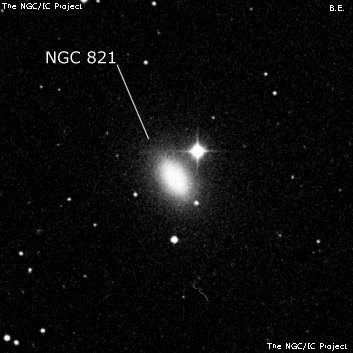
William Herschel discovered NGC 821 = H I-152 = h193 on 4 Sep 1786 (sweep 582) and commented "pB, vS, R, bM, 1' sf a considerable star with a small one sf the nebula." Dreyer's 1912 notes to the Second Catalogue mentions "A second obs. (Sweep 591, Sept. 18, 1786) describes it as vB, vS, lE, vBN. But the neb. is in reality only pB, second class." John Herschel also logged it on 19 Jan 1828 (sweep 121) as "Not vB; R; sbM to nucl; has a *1m sp, dist 55"." R.J. Mitchell, using the 72" on 18 Dec 1856, recorded a "bMN, E spnf, S * in s end." This star is around mag 15.5 and was not seen in my observation.
200/250mm - 8" (11/8/80): fairly faint, small, compact. A mag 10 star is just 1' NW.
400/500mm - 17.5" (12/18/89): fairly bright, fairly small, oval 3:2 SW-NE, very bright elongated core. Located just 1.1' SE of mag 10 SAO 92805!
Notes by Steve Gottlieb
NGC 691
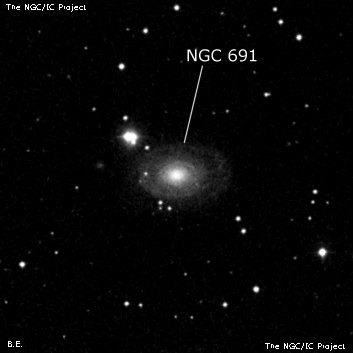
William Herschel discovered NGC 691 = H II-617 on 13 Nov 1786 (sweep 636) and noted "F, cL, vglbM". The NGC position matches UGC 1305 = PGC 6793.
300/350mm - 13.1" (9/29/84): fairly faint, fairly large, almost round, very diffuse, weak concentration. A close double star is off the NE edge. Located 15' SSE of NGC 680 in the NGC 697 group.
400/500mm - 18" (11/22/03): bright, large, slightly elongated E-W, ~2.0'x1.5'. Fairly sharp concentration with a well-defined 45" core surrounded by an unconcentrated halo. A close pair of mag 9-10 stars (uncatalogued) is just off the northeast edge! NGC 691 is the brightest in the NGC 691 group (also called the NGC 697 group and LGG 034) that includes NGC 678, NGC 680, NGC 691, NGC 694, NGC 695, NGC 697, IC 163, IC 167, IC 1730 and others.
Notes by Steve Gottlieb
NGC 972
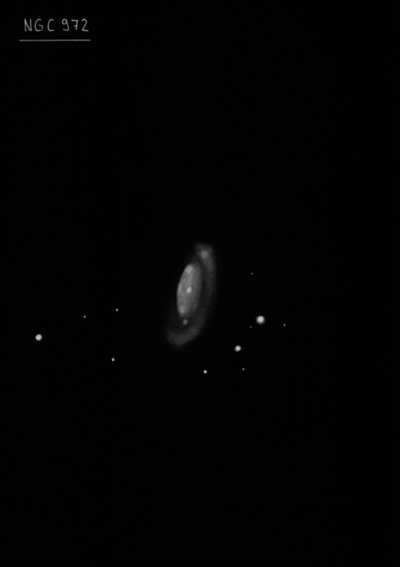
William Herschel discovered NGC 972 = H II-211 = h232 = St III-9 on 11 Sep 1784 (sweep 266) and logged "F, pL, lE, bM, just north of 2 stars." On 11 Jan 1787 (sweep 680) he recorded "pB, cL, E from sp to nf [should be np to sf] but nearer the meridian, mbM, about 1' north of 3 stars in a row." On 16 Sep 1828 (sweep 178), John Herschel wrote "pB, lE, pgmB". Stephan independently found the galaxy again on 11 Dec 1871 with the 31" reflector at the Marseille Observatory and this observation led to the entry 5247 in the GC Supplement. Dreyer combined the two GC entries (560 = 5247) in the NGC. NGC 972 was observed 15 times at Birr Castle. On 7 Oct 1855, R.J. Mitchell recorded "has a knot in p edge [probably an HII region]; neb spreads out and fades away gradually sf."
200/250mm - 8" (11/8/80): fairly faint, round, bright core, bright double star to SW.
400/500mm - 17.5" (12/23/92): bright, fairly large, elongated 2:1 NW-SE, 2.0'x1.0', large bright core dominates, much fainter outer halo, appears brighter on the southeast side. Three stars (including two mag 9 stars at 45" separation) are in a line off the southwest flank and equally spaced.
Notes by Steve Gottlieb
NGC 1156
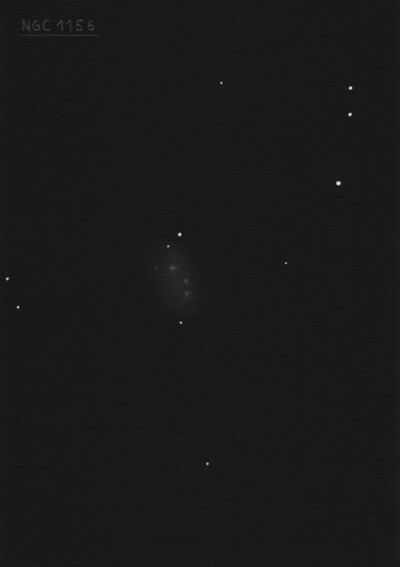
William Herschel discovered NGC 1156 = H II-619 on 13 Nov 1786 (sweep 637) and recorded "pB, cL, pmE in the meridian, resolvable, within a minute of a star." His position was just off the southeast side of this dwarf Irregular. Four observations were made with Lord Rosse's 72".
200/250mm - 8" (12/6/80): faint, diffuse, slightly elongated SSW-NNE. A mag 12.5 star is just NW of the NE flank.
400/500mm - 18" (10/25/08): fairly bright, fairly large, elongated 5:2 SSW-NNE, 2.0'x0.8'. Brighter along the major axis with a slightly brighter core. The outline is roughly rectangular and the surface brightness is irregular. The southwest end appears asymmetric. A mag 11.5 star is at the north end, 0.9' from center.
600/800mm - 24" (12/12/17): at 375x; fairly bright, fairly large, elongated 5:2 SSW-NNE, ~2.25'x0.9', no well defined core, noticeably irregular outline and surface brightness. The low surface brightness halo appeared to spread out on the south end and the northeast side had an indentation. The main body was somewhat uneven or mottled with a couple of very small, low contrast knots suspected. A mag 12 star is just inside the NNW border [0.9' from center] and a mag 15 star is closer in [0.7' NNE of center]. Another mag 15 star is at or just beyond the southern edge [1.0' S of center]. In a friend's 28" at 438x, a knot was confirmed west of center (~0.3'), as well as a knot northeast of center (~0.3').
Notes by Steve Gottlieb
NGC 877
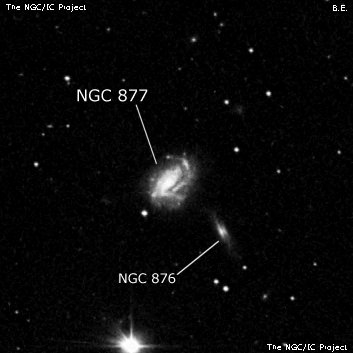
William Herschel discovered NGC 877 = H II-246 = h210, along with NGC 871, on 14 Oct 1784 (sweep 289) and recorded "F, pL, E, south of a considerable star [the galaxy is 5' north of the star]; the situation of these two is very similar with regard to the star, and rather remarkable; the distance from the star about 4 or 5'." John Herschel made an observation on 7 Sep 1828 (sweep 173): "pB; R: pgbM; a small * sf; dist 1' and a * 9m 5' dist nearly s[outh], a little foll." R.J. Mitchell, LdR's assistant on 3 Nov 1855, recorded "[NGC 877] has a * or knot in p end, centre suspected resolvable; dark space running along southern side of nucleus?" The "dark space" is a gap between the core and a spiral arm and the "* or knot in p end" appears to be an HII region.
200/250mm - 8" (1/1/84): faint, fairly small, even surface brightness. An extremely faint star is at the SSE edge. A mag 9 star is 4' SE. NGC 871 lies 12' W.
400/500mm - 17.5" (12/18/89): moderately bright, fairly small, oval 3:2 NW-SE, broadly concentrated halo. A mag 13.5 star is at the SE end 1.1' from center. Located 5' NNW of mag 8.0 HD 14192. Brightest in a group with NGC 876 2' SW and NGC 871 12' W.
Notes by Steve Gottlieb
NGC 1012
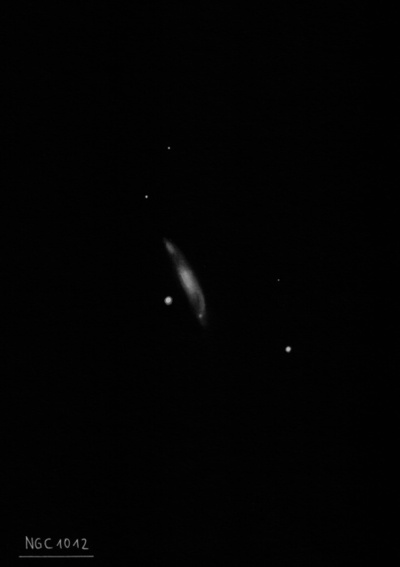
William Herschel discovered NGC 1012 = H III-152 = h241 on 11 Sep 1784 (sweep 266) and recorded "vF, pS, of equal light." On 11 Jan 1787 (sweep 680) he logged "F, irr figure, some stars visible, but they seem not to belong to it." On 16 Sep 1828 (sweep 178), John Herschel recorded "pB; irreg R; bM; 18"; resolvable. RA doubtful". R.J. Mitchell made a sketch with the 72" on 23 Nov 1857 and it was included in LdR's 1861 publication (plate XXV, figure 4).
400/500mm - 17.5" (11/27/92): fairly faint, fairly small, elongated 3:2 ~N-S, broad concentration. Unusual appearance as a mag 13.5 star is embedded just east of the core.
Notes by Steve Gottlieb
NGC 678
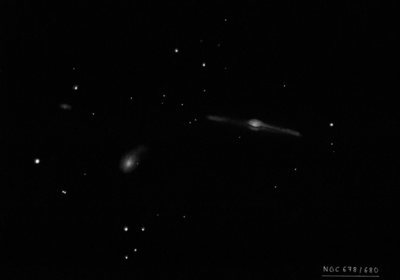
William Herschel discovered NGC 678 = H II-228, along with NGC 680, on 15 Sep 1784 (sweep 274) and described them together as "Two. Both F, pS, irregularly R." The NGC position is accurate. On 13 Nov 1786 (sweep 636) he logged "pB, S, mbM."
300/350mm - 13.1" (9/29/84): moderately bright, moderately large, bright core, elongated 3:1 ~E-W. Forms a pair with NGC 680 5' ESE in the NGC 697 group.
400/500mm - 18" (11/22/03): fairly bright, moderately large, very elongated 7:2 WSW-ENE, 3.0'x0.8'. Sharply concentrated with a small bright core that increases to the center. The extensions are much fainter. Forms a pair with NGC 680 5' ESE in the NGC 697 group (also called the NGC 691 group).
600/800mm - 24" (8/30/16): fairly bright, large, very elongated 4:1 WSW-ENE, 2.5'x0.6'. Sharply concentrated with an unusually brighter core that is irregularly round, stellar nucleus. The arms are long and low surface brightness, but the warped dust lane was not seen. Forms a striking pair with NGC 680 5.5' ESE.
Notes by Steve Gottlieb
NGC 932
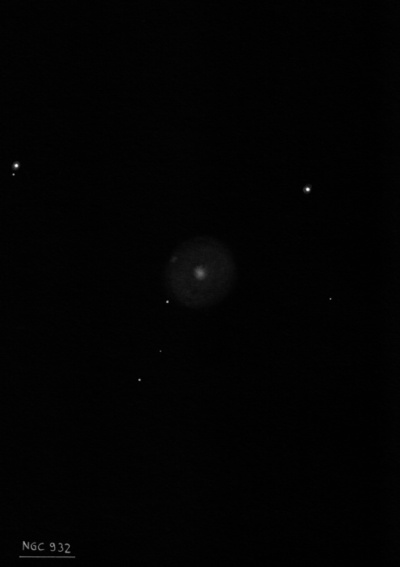
William Herschel discovered NGC 932 = H II-489 on 29 Nov 1785 (sweep 481) and noted "F, S, lE, 3 stars visible in it, but they seem not to belong to it." His position is 2' north of UGC 1931 = PGC 9379. This galaxy is misidentified as NGC 930 in RNGC, MCG and RC3 (as well as secondary sources such as Megastar). UGC and CGCG equate the numbers NGC 930 = NGC 932, but only NGC 932 should apply. See notes for NGC 930.
400/500mm - 17.5" (1/20/90): fairly faint, small, round, bright core. A very faint 15th magnitude "star" (emission knot) is involved at the NE end. A mag 14 star is 1' ESE. NGC 938 lies 10' ESE.
600/800mm - 24" (1/1/16): fairly faint/moderately bright, round, 40" diameter, small bright core. A mag 14 star is 50" SE and a mag 12.4 star is 1.7' NW. Member of a large group (LGG 061), inlcuding NGC 924, 935, 938 and 976.
Notes by Steve Gottlieb
NGC 770
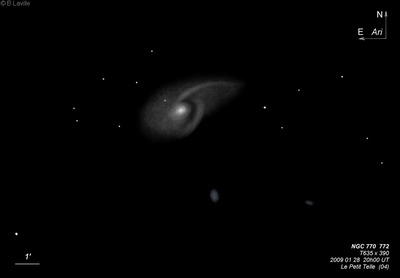
R.J. Mitchell (GC 464) discovered NGC 770 on 3 Nov 1855 while observing NGC 772. He noted, "has companion neb. 5' or 6' south." Dreyer later measured an accurate offset. Heinrich d'Arrest (GC 461) independently found NGC 770 in 1861 and it was listed twice in the GC. Both entries were combined in the NGC with an accurate position.
300/350mm - 13.1" faint, very small, round, small bright core. Located 3.5' SSW of NGC 772.
400/500mm - 18" (12/3/05): fairly faint, fairly small, round, 30" diameter, increases to a small bright core. This is a companion to NGC 772 and may be the cause of its bright, disturbed spiral arm.
900/1200mm - 48" (11/1/13): bright, fairly small, slightly elongated SSW-NNE, ~40"x32", very high surface brightness. Forms a double system 3.5' SSW of NGC 772, a showpiece spiral.
Notes by Steve Gottlieb
NGC 935
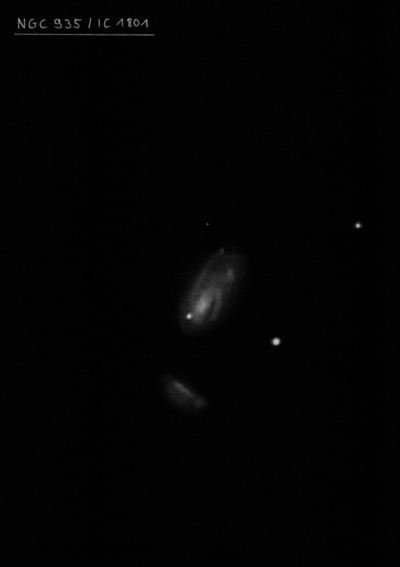
Lewis Swift discovered NGC 935 = Sw. II-22 on 18 Sep 1885 with the 16" refractor at Warner Observatory. His position is just 4 sec of RA east of PGC 9388 (part of Arp 276). He mentions the bright star close west though the description implies the galaxy precedes the star. I'm surprised that Swift missed IC 1801 at the SE end.
400/500mm - 17.5" (1/20/90): fairly faint, fairly small, elongated 2:1 NW-SE. A mag 14 star is superimposed. Located 1.2' NE of a mag 10 star. Forms a double system with IC 1801 off the southeast end. IC 1801 appeared very faint, very small, elongated SW-NE, low surface brightness.
Notes by Steve Gottlieb
IC 195
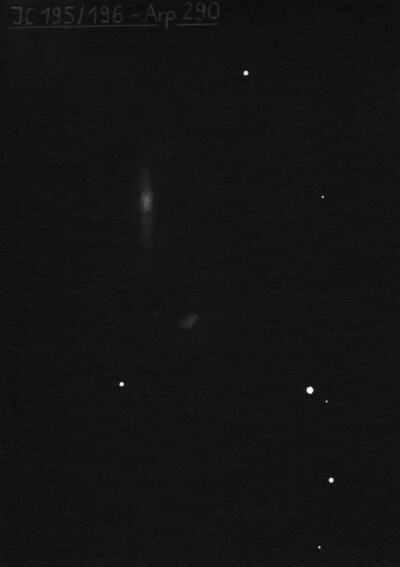
Lewis Swift discovered IC 195 = Sw. IX-10, along with IC 196, on 20 Oct 1889 and recorded "eeF; S; R; F * nr south; sp of 2 [with IC 196]." His position and description is a good match with UGC 1555.
400/500mm - 17.5" (11/17/01): faint, small, bright core, faint extensions NW-SE, 0.4'x0.2'. A mag 12 star lies 1.4' S. Forms a close pair (Arp 290) with brighter IC 196 2.2' NE. Preceding by just 2.2' is a nice mag 10.5/12.5 pair at 15" with two additional mag 12 stars to the SSW of the closer pair.
900/1200mm - 48" (10/29/16): at 488x and 610x; fairly bright, moderately large, sharply concentrated with a bright, elongated 2:1 core NNW-SSE and highlighted by a stellar nucleus. The halo or spiral arms are very low surface brightness and extend 5:2 NW-SE, ~1.0'x0.4'. A distracting 15" pair of mag 10.4/12.7 stars is 2.3' W. Forms an interacting pair (Arp 290) with IC 196 2.2' NE.
Notes by Steve Gottlieb
NGC 694
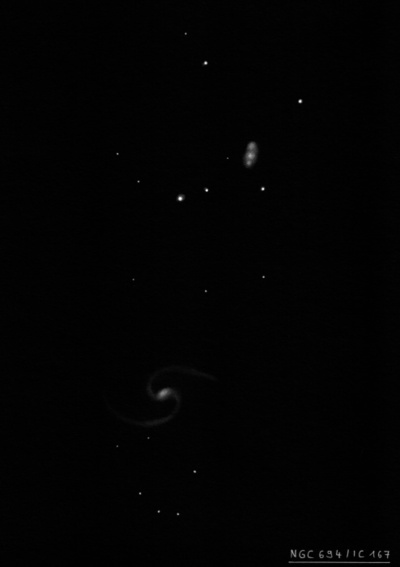
Heinrich d'Arrest discovered NGC 694 on 2 Dec 1861 with the 11-inch refractor at Copenhagen. He noted the nebula was collinear with two mag 15 stars [probably to the NW and SE].
300/350mm - 13.1" (9/29/84): faint, small, round, diffuse, even surface brightness. Member of the NGC 697 group (also called the NGC 691 group) with IC 167 5.5' SSE.
400/500mm - 18" (11/22/03): moderately bright, fairly small, 0.7'x0.5'. Fairly high surface brightness, which increases to an occasional faint stellar nucleus. A mag 10.5 star is 2.3' SE. IC 167, which lies 5.5' SSE, is very faint, elongated 4:3, 0.8'x0.6', low surface brightness.
Notes by Steve Gottlieb
NGC 876
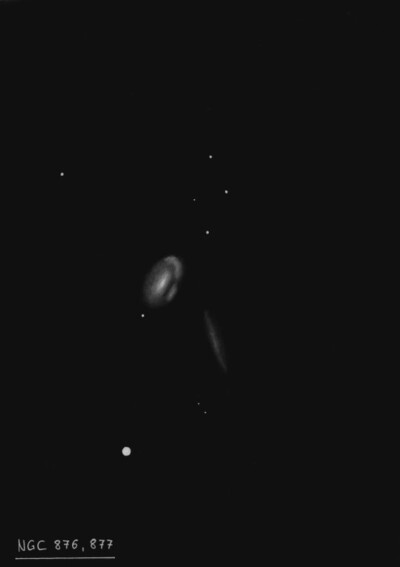
R.J. Mitchell discovered NGC 876 on 22 Nov 1854 with Lord Rosse's 72", during his observation of h210 = NGC 877. He noted this nebula as "sp [h210 = NGC 877] I suspect a vvF patch" and labeled it on the sketch as Delta. Copeland computed a micrometric position on 15 Nov 1873. The field of NGC 870, 871, 876 and 877 was observed at Birr Castle 14 times from 1850 to 1875.
400/500mm - 17.5" (12/18/89): extremely faint, visible for moments with averted, very small, almost round. A pair of mag 14.5 stars lie 1.5' S. Located just 2' SW of NGC 877 and 4' NW of mag 8 SAO 92878.
Notes by Steve Gottlieb
HCG 18
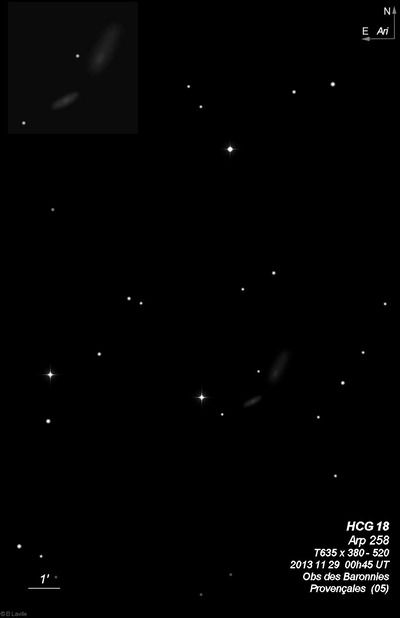
| Type | GALCL [S2] |
| RA | 02:39:06.8 |
| Dec | +18:22:59.0 |
| major_axis | 2.6' |
| mag | 12.7 |
| surface_bright | 99.9 |
HCG 20
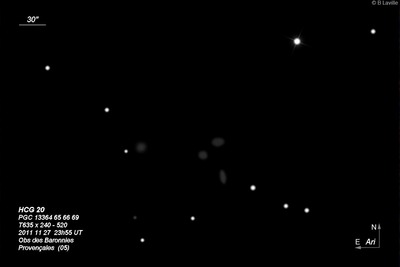
| Type | GALCL [S3] |
| RA | 02:44:15.0 |
| Dec | +26:06:11.0 |
| major_axis | 2.0' |
| mag | 13.0 |
| surface_bright | 99.9 |
